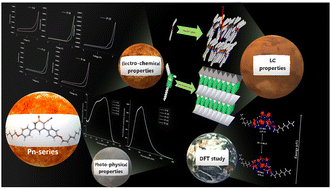New luminescent ordered liquid crystalline molecules with a 3-cyano-2-pyridone core unit†
Abstract
The self-organized states of liquid crystals (LCs) have recently received a lot of attention because of their various applications, especially in the fields of electron transport materials and optoelectronic devices. In most of these applications, molecules containing a donor–acceptor skeleton have been widely employed and generally these molecular frameworks have been designed mainly on the basis of the donor–acceptor concept. Inspired from this concept, we synthesized a series of new donor–acceptor based luminescent molecules, i.e. 4,6-bis(4-alkyloxyphenyl)-2-oxo-1,2-dihydropyridine-3-carbonitrile (Pn-series), carrying variable alkoxy chains [i.e. n = 8, 10, 12, 14, 16]. The structures of the synthesized molecules were confirmed by various spectral analyses. Further, their absorption and emission studies indicated that these molecules show blue light emitting properties. Moreover, the experimentally obtained optical band gap was analogous to the theoretical band gap calculated from the DFT study. The first two members of the Pn-series (n = 8 and 10) are non-mesogens. As the alkyl chain length increased to n = 12 and n = 14, the smectic C phase appeared along with an additional low temperature ordered lamellar phase. When n = 16, the smectic C phase disappeared and the compound exhibited only an ordered lamellar phase. This ordered lamellar phase is mainly due to the face to face alignment which makes these molecules potential candidates for electron transport materials and optoelectronic devices.



 Please wait while we load your content...
Please wait while we load your content...